Bulletin – January 2009 Australia and the Global Market for Bulk Commodities[1]
- Download 151KB
Introduction
The share of Australia's export earnings derived from bulk commodities – coking coal, thermal coal and iron ore – has increased over recent years, consistent with the large price increases seen until mid 2008. This article discusses the broad structure of the global iron ore and coal markets as well as the key markets for Australia's exports. While Australia is the world's largest exporter of bulk commodities, Australia's share of global production is much smaller, reflecting the fact that a large proportion of global production – especially Chinese production – is not traded internationally. From this perspective, developments on the supply side, as well as the demand side, within China have the potential to affect the global coal market and prices, particularly in the context of the current global economic slowdown.
Bulk Commodities and the Australian Economy
With coal and iron ore prices roughly tripling in Australian dollar terms over the six years to mid 2008, the share of bulk commodities in Australia's trade rose considerably. In 2008, bulk commodities accounted for an estimated 28 per cent of the value of total exports – almost five times larger than in 2002 – and over one-half of total resource exports (Table 1). Coking coal and iron ore each accounted for 11 per cent of Australia's total exports, with the share of coking coal exports rising particularly sharply in 2008 after the tripling of the 2008/09 contract price. Thermal coal has a relatively lower share, recently accounting for an estimated 5 per cent of total exports.[2]
| 2002 | 2005 | 2007 | 2008(a) | |
|---|---|---|---|---|
| Total | 35 | 41 | 46 | 53 |
| of which: | ||||
| Bulks | 6 | 10 | 15 | 28 |
| – Coking coal | 2 | 4 | 5 | 11 |
| – Thermal coal | 2 | 2 | 3 | 5 |
| – Iron ore | 2 | 3 | 6 | 11 |
|
(a) 2008 shares are estimated using ABS data for the first nine months of 2008. Sources: ABS; RBA |
||||
The Global Market for Bulk Commodities
Given the significance of coal and iron ore in Australia's trade, it is important to understand the global markets for these commodities. This section analyses production and consumption shares of bulk commodities, since the structure of the global bulk commodity trade ultimately reflects cross-country patterns of natural resource endowments relative to their demand for bulk commodities.
As the first two columns of Table 2 show, a significant proportion of global coal output is produced for domestic consumption. For example, roughly three-quarters of global thermal coal is produced and consumed within just three countries – China especially, as well as the United States and India. This partly reflects the fact that countries with abundant supplies of thermal coal tend, not surprisingly, to rely heavily on this resource for electricity production. China also produces and consumes significant proportions of global coking coal and iron ore output, reflecting its own resources of these commodities and their importance in the steel production process.
| Producers | Consumers | Exporters | Importers | ||||
|---|---|---|---|---|---|---|---|
| Coking coal | |||||||
| China | 46 | China | 50 | Australia | 57 | Europe | 24 |
| Australia | 18 | Europe | 12 | Indonesia | 13 | Japan | 24 |
| Russian Fed | 8 | Japan | 7 | United States | 12 | Korea | 10 |
| United States | 6 | India | 7 | Canada | 11 | India | 10 |
| Indonesia | 4 | Russian Fed | 7 | Russian Fed | 6 | Brazil | 4 |
| Thermal coal | |||||||
| China | 46 | China | 46 | Indonesia | 27 | Europe | 26 |
| United States | 20 | United States | 20 | Australia | 16 | Japan | 18 |
| India | 9 | India | 10 | Russian Fed | 12 | Korea | 9 |
| South Africa | 5 | Europe | 6 | Columbia | 10 | Taiwan | 9 |
| Indonesia | 4 | South Africa | 4 | South Africa | 9 | China | 6 |
| Iron ore | |||||||
| Brazil | 20 | China | 44 | Brazil | 32 | China | 46 |
| China | 20 | Russian Fed | 9 | Australia | 32 | Europe | 21 |
| Australia | 18 | Europe | 9 | India | 11 | Japan | 17 |
| India | 13 | Japan | 8 | South Africa | 4 | Korea | 6 |
| Russian Fed | 12 | Korea | 7 | Canada | 3 | Taiwan | 2 |
|
Sources: ABARE; AME Mineral Economics; International Energy Agency; RBA |
|||||||
Abstracting from these instances where production is consumed within national borders, the pattern of international trade in the bulk commodities becomes clearer. For each commodity, the countries in Table 2 can be divided into net exporters and net importers. The former group includes those countries that are endowed with significant reserves of bulk commodities but consume only a small fraction of this output, while the large net importers – such as Europe and Japan – have significant consumption demands but only limited domestic supplies. As shown, Australia was one of the largest exporters of bulk commodities in the world in 2007, accounting for 57 per cent of global coking coal exports, 32 per cent of iron ore exports and 16 per cent of thermal coal exports. In contrast, Australia's share of global production is only 18 per cent for coking coal and iron ore and 4 per cent for thermal coal.
Australia is the largest exporter of coking coal, and the second largest exporter of thermal coal behind Indonesia. Europe and Japan are the world's largest importers of coal, together accounting for roughly one-half of world coking and thermal coal imports in 2007. Turning to iron ore, Brazil and Australia are the world's largest exporters, while China accounts for almost one-half of global imports, with Europe, Japan and Korea accounting for much of the rest.
The Direction of Australia's Exports
The direction of Australia's bulk commodity exports broadly reflects the composition of world imports outlined above. This is particularly the case for coking coal, where Europe and Japan – the world's largest importers – accounted for roughly one-half of Australia's coking coal exports in 2007 (Graph 1). However, Europe was overtaken recently by India as Australia's second largest market, with India's demand for Australian coking coal more than doubling over the past five years. China accounts for very little of Australia's coking coal exports, given its own large domestic coal reserves.

While Europe and Japan are the two largest importers of thermal coal, only the latter is a significant market for Australian exports, reflecting comparative transport costs from Australia (Graph 1). In contrast, the European market has typically been serviced by other suppliers, such as the United States and South Africa. Nevertheless, the share of Australian thermal coal exports to Europe did rise around the time of the Asian financial crisis, reflecting a diversion of Australian coal from crisis-affected Asia to this market (Graph 1).
Much of China's demand for iron ore is sourced from Australia, with China accounting for more than one-half of Australia's exports in 2007. This share has increased rapidly over the past five years, after an extended period when Japan had been the largest export destination for Australia's iron ore (Graph 2). While Europe is currently the world's second largest importer of iron ore, it is only Australia's fifth largest export market, consistent with Brazil's closer proximity to Europe.
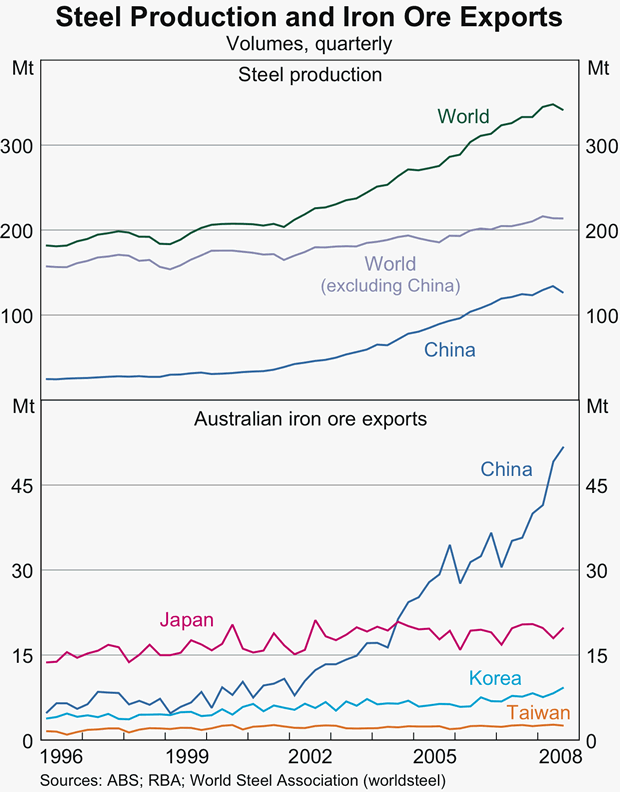
China and the Global Market for Bulk Commodities
China has a significant influence on global bulk commodity markets, though the nature of this influence varies across commodities. Not surprisingly, with China being the largest iron ore importer, changes in Chinese domestic demand – particularly in the steel sector – have a significant influence on global iron ore prices. The rapid expansion of Chinese steel production from around 2002 to mid 2008 resulted in a significant increase in Chinese demand for imported iron ore (Graph 2), which contributed to the five-fold increase in global iron ore prices (in US dollar terms) over this period. More recently, steel production in China has slowed noticeably, and accordingly, so has Chinese demand for iron ore imports.
Given its relatively limited role in global coal trade, China's influence on the global coal market is more subtle. The scale of China's domestic coal production (Graph 3), and the fact this output can – in principle – be exported, mean that internal developments in China have the potential to significantly alter the dynamics of the global coal market. Between 1997 and 2001, for example, Chinese thermal coal consumption fell by 10 per cent in cumulative terms while domestic production declined by 7½ per cent, as growth in electricity generation slowed (Graphs 4 and 5). This resulted in a large build in domestic coal stocks relative to the volume of globally traded coal. As domestic coal prices softened, Chinese producers shifted domestic supply to the international market, resulting in a sharp increase in thermal coal exports (Graph 4).[3] By 2003, China had become the third largest thermal coal exporter, accounting for over 15 per cent of global trade. This surge in Chinese coal exports partly accounts for the 20 per cent decline in global coal prices between 2001 and 2003.
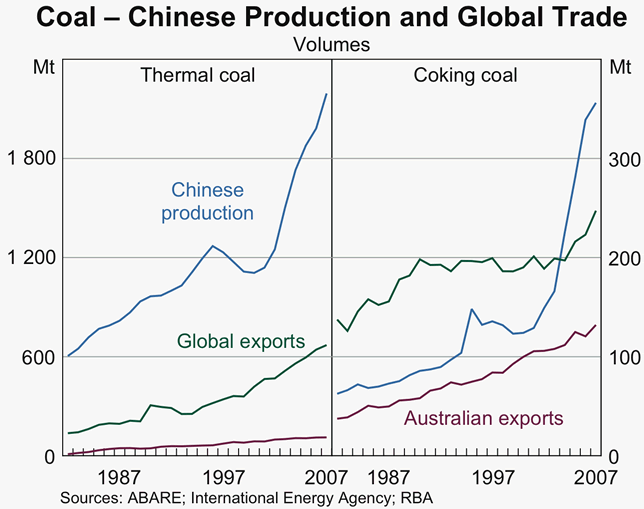
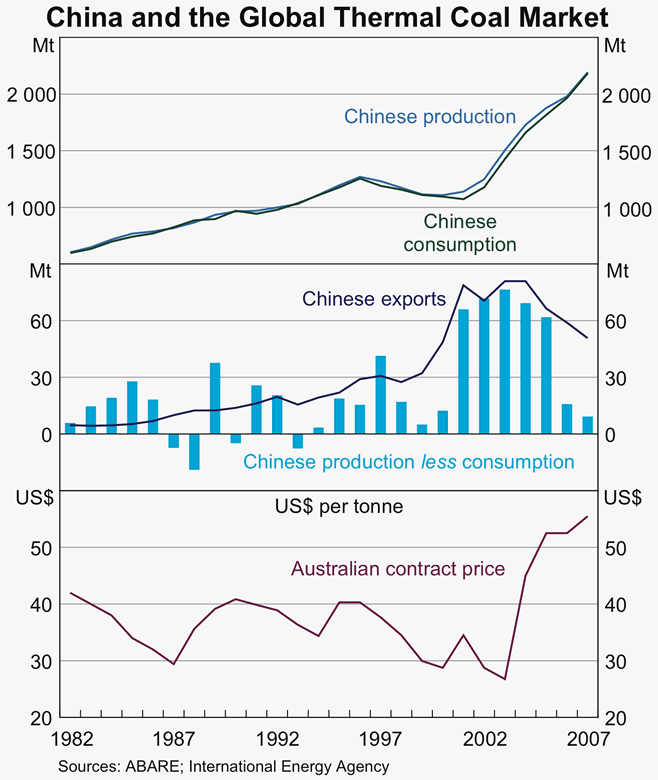
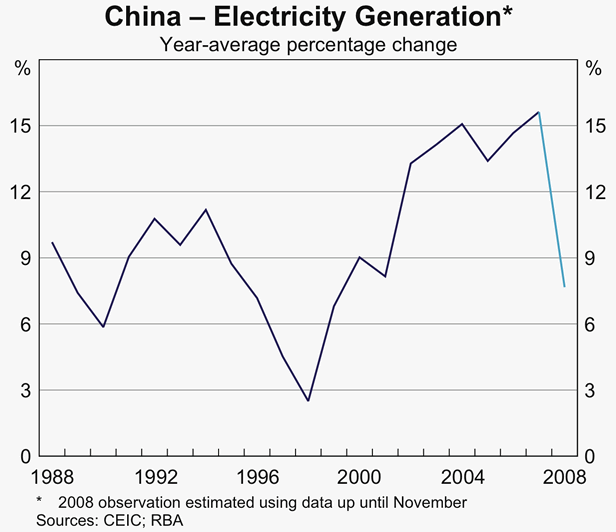
Just as the slowdown in Chinese domestic demand around the turn of the decade triggered a noticeable surge in Chinese coal exports, the subsequent pick-up in Chinese industrial activity – which in large part was fuelled by coal – prompted a reversal of this trend. While final consumption of coal by Chinese industry actually declined over the second half of the 1990s, it rose sharply between 2000 and 2006, underpinned by particularly strong demand from the iron and steel sector (Table 3). Reflecting this, Chinese coal exports fell by roughly 40 per cent between 2003 and 2007, contributing to the doubling in global coal prices (in US dollar terms) over this period (Graph 4). By 2007, Chinese coking coal exports were at their lowest level since the late 1980s.
| Level Millions of tonnes | Average annual growth Per cent | ||||
|---|---|---|---|---|---|
| 1995 | 2000 | 2006 | 1995–2000 | 2000–06 | |
| All sectors | 517 | 368 | 562 | −7 | 7 |
| Industry sector | 351 | 260 | 429 | −6 | 9 |
| – Iron and steel | 74 | 73 | 169 | 0 | 15 |
| Other sectors | 166 | 107 | 133 | −8 | 4 |
|
Source: International Energy Agency |
|||||
The Outlook
Coal and iron ore commodity prices rose substantially over 2002/03 to mid 2008, with the 2008/09 contract price increases being particularly large (Graph 6). The tightening in these markets over this period mostly reflected strong demand from developing Asia, though constraints on the supply side also contributed.
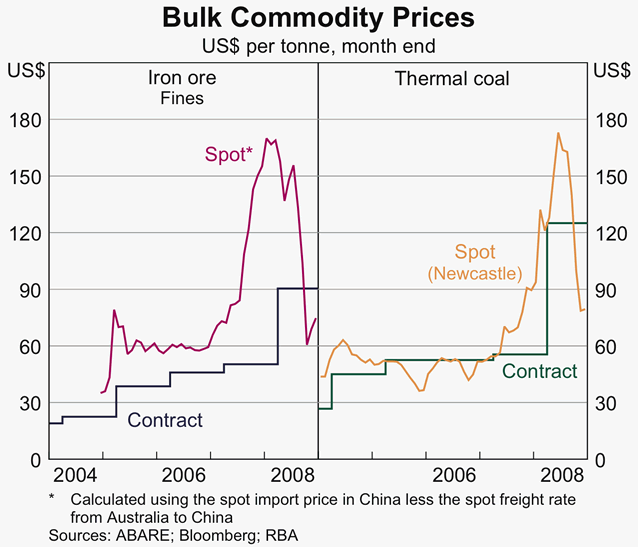
More recently, however, bulk commodity prices on the spot market have fallen sharply (Graph 6). Given this development, market analysts have significantly revised down their expectations for bulk commodity prices over recent months, with the next set of contracts expected to be settled at significant discounts to the 2008/09 contract prices. This reflects the slowing in global industrial activity and a partial easing of constraints on the supply side. Developments on the demand side – especially in China which accounts for close to half of global demand – will continue to have a significant influence on prices for coal and iron ore. Moreover, as discussed earlier, past experience suggests that the extent to which Chinese domestic supply adjusts to the slowdown in Chinese demand will also be relevant, particularly for coal prices.
Footnotes
This article was prepared by Dan Andrews of Economic Analysis Department. [1]
For a discussion on recent developments in resource export volumes, see Andrews and Arculus (2008), ‘Australian Exports and Developing Asia’, RBA Bulletin, June, pp 1–11. [2]
China's exports of coking coal also rose noticeably from about 2001, as domestic consumption slowed more quickly than production. [3]